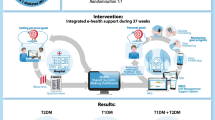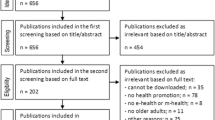Abstract
Background: Establishing a comprehensive community-based elderly care service system has become a major strategy to address aging issues in China. E-health applications such as a self-monitoring health device could potentially solve many of the challenges faced by elderly care. In this study, we adapted an evaluation framework to investigate the effect of an integrated care model.
Methods/Design: This study mainly evaluates the model’s effect on the users’ self-rated health, hypertension control and life-style change. We recruit 180 elderly participants (over 60 years old) from three communities in Beijing, Hefei and Lanzhou. A comprehensive questionnaire will be used in the baseline survey. A pair of participants with similar statues will be randomly assigned to intervention groups and control groups. The intervention group will receive a home-based self-monitoring device that records daily blood pressure data. Primary care physicians will contact them bi-weekly to give feedbacks on their blood pressure control and other care need. Additionally, participants’ family members will be involved in the process to improve participants’ adherence. After six months of intervention, we will conduct another questionnaire survey that elicits participants’ responses on self-rated health, life-style, satisfaction and cost-effectiveness of the device. Feedbacks from the primary care physicians, family and study participants will be collected as well through face-to-face interviews.
Discussion: Our design attempts to capture the effectiveness of integrated E-health care model from different angles. If this model can improve elderly health management, it will in turn provide a feasible and effective solution for establishing the eHealth-based community collaborative elder care nationally wide.
You have full access to this open access chapter, Download conference paper PDF
Similar content being viewed by others
Keywords
1 Introduction
Elderly care is a worldwide social and economic challenge for the public health system, and it requires the development of new management strategies [1]. China is heading for an elderly population crisis. Along with the epidemiologic transition, chronic conditions have become the predominant contributor to disability among Chinese elderly [2]. Establishing a comprehensive community-based elderly care service system has become a major strategy to address aging issues in China. E-health applications such as self-monitoring health devices could potentially solve many of the challenges faced by elderly care, especially for those with chronic diseases. This device will help by transmitting elder-related data to share information among primary care physicians, family members and professional caregivers, thus creating an “elder-centric” collaborative care service system [1].
Despite the benefits and maturity of the technology, E-health applications are still not widespread in China. Small scale services, not integrated into local healthcare systems, dominate the scene [3]. Evaluation of integrated care service delivery processes will improve the current scientifically based data centered on barriers and facilitators toward integrated care delivery. Beyond this, scientific research in the field will generate outcomes from the perspectives of all involved with integrated care service delivery [3].
Although information evaluating the effectiveness of E-health application is mostly lacking [3], there were some studies developed models to assess health technologies. The European network for Health Technology Assessment (EUnetHTA) provided a practical tool for health technology assessment in Europe [4]. A framework for assessment of telemedicine technologies, named MAST, was established for decision makers to assist them in choosing the most efficient and cost-effective health technologies [3]. SmartCare trials evaluated the functions and impacts of the integrated health services from the point of view of the different principal roles [5].
In this study, we adapted an evaluation framework to investigate the effect of an integrated care model that combines a home-based self-monitoring health device, primary care physicians, and family members of the elderly over a six-month period in China.
2 Methods and Design
This study mainly evaluates the model’s effect on the users’ self-rated health, hypertension control and life-style changes. We recruit 180 elderly participants (over 60 years old) from three communities in Beijing, Hefei and Lanzhou. People with a hearing disorder or dementia will be excluded from the study. The starting point of the assessment would be when the elderly residents have been involved in the integrated-care program.
A comprehensive questionnaire that covers demographic information, life-style, self-rated health, disease history, health management, health service usage, social network, health literacy, and cognitive function will be used in the baseline survey. Social network measure is the abbreviated Lubben Social Network Scale [6]. Cognitive function is assessed by the Mini Mental State Examination (MMSE) [7]. A pair of participants with similar statues will be randomly assigned to an intervention group and to a control group. The intervention group will receive a home-based self-monitoring device that records daily blood pressure data. Primary care physicians will contact the participants bi-weekly to give feedback to help regulate their blood pressure and other care needs. Additionally, participants’ family members will be involved in the process to improve participants’ adherence, while, the control group will receive usual care. After six months of intervention, we will conduct another questionnaire survey that elicits participants’ responses on self-rated health, life-style, satisfaction and cost-effectiveness of the device. Feedbacks from the primary care physicians, family and study participants will be collected as well through face-to-face interviews to understand the organizational changes and the effectiveness of integration of different care approaches.
All outcomes are adapted from SmartCare and MAST models [3, 5], and presented below in Table 1: Outcomes, timing and explanation for variables. Also, the table indicates the preferred collection methods for each variable, and the possible reasons for assessment. Multidisciplinary assessment involves evaluation of the outcomes of the specific E-health application compared with control groups, where the outcomes divide into five domains. The domain of Health Status Measures describes of the health concerns of the patients and also includes demographics and social related factors. The domain of Safety provides identification and assessment of hazards. The domain of the Elderly/Physicians/Family considers issues related to the perception of the elderly and families or physicians of the E-Health application including the participants and relatives acceptance of the technology. The domain of Economics evaluates the elderly’s willingness to pay for the technology and the service efficiency benefits. Domain of Organizational impact measures is an assessment of what kind of resources have to be mobilized and organized when implementing a new technology, and what kind of changes or consequences the use can further produce in the organization.
Ethics approval was obtained from the Ethics Review Committee of the Chinese Academy of Medical Sciences and Peking Union Medical College, Beijing, China (X170315009). All study participants will be provided written informed consent.
3 Discussion
Chronic disease prevention and management become important as a population ages [8]. E-health is emerging to address the limited capacity of the health care system to provide health behavior change and chronic disease management interventions [9].
The integrated E-health care model in this project involves multifaceted intervention. The overall aim of this study was to provide a protocol for assessing the effectiveness and contribution of an integrated E-health care model to elderly health, based on need the for further information by users.
Our design attempts to capture the effectiveness of the integrated E-health care model from different perspectives. If this integrated model can improve elderly health management, it will in turn provide a feasible and effective solution for establishing the eHealth-based community collaborative elder care nationally wide. However, due to time-constraints, this study only assesses the short-term effect of an integrated E-health care model on health and lifestyle, additional follow up should be conducted to determine the long-term effects and outcomes.
References
Maresca, G., et al.: Moving towards novel multidisciplinary approaches for improving elderly quality of life: the emerging role of telemedicine in Sicily. J. Telemed. Telecare (2018). https://doi.org/10.1177/1357633X17753057
Chen, H., Wang, H., Crimmins, E.M., Chen, G., Huang, C., Zheng, X.: The contributions of diseases to disability burden among the elderly population in China. J. Aging Health 26(2), 261–282 (2014)
Kidholm, K., et al.: A model for assessment of telemedicine applications: mast. Int. J. Technol. Assess. Health Care 28(1), 44–51 (2012)
Kristensen, F.B., et al.: Practical tools and methods for health technology assessment in Europe: structures, methodologies, and tools developed by the European network for Health Technology Assessment, EUnetHTA. Int. J. Technol. Assess. Health Care 25(Suppl. 2), 1–8 (2009)
SmartCare: Smartcare (2013). http://www.pilotsmartcare.eu/home.html. Accessed 25 Feb 2018
Crooks, V.C., Lubben, J., Petitti, D.B., Little, D., Chiu, V.: Social network, cognitive function, and dementia incidence among elderly women. Am. J. Public Health 98(7), 1221–1227 (2008)
Folstein, M.F., Folstein, S.E., McHugh, P.R.: ‘Mini-mental state’. A practical method for grading the cognitive state of patients for the clinician. J. Psychiatr. Res. 12(3), 189–198 (1975)
Ahern, D.K., Kreslake, J.M., Phalen, J.M.: What is eHealth (6): perspectives on the evolution of eHealth research. J. Med. Internet Res. 8(1), e4 (2006)
Farnia, T., Jaulent, M.C., Marchand, G., Yasini, M.: A collaborative evaluation framework for biometric connected devices in healthcare. Stud. Health Technol. Inform. 245, 69–73 (2017)
Funding
Supported by the grant from National Natural Science Foundation of China (grant number: 71661167004).
Author information
Authors and Affiliations
Corresponding author
Editor information
Editors and Affiliations
Ethics declarations
No conflict of interest.
Rights and permissions
Copyright information
© 2018 Springer International Publishing AG, part of Springer Nature
About this paper
Cite this paper
Li, J., Jin, P., Liu, Y. (2018). The Effect of an Integrated E-health Care Model on the Health and Life-Style of Chinese Elderly: Study Protocol. In: Stephanidis, C. (eds) HCI International 2018 – Posters' Extended Abstracts. HCI 2018. Communications in Computer and Information Science, vol 851. Springer, Cham. https://doi.org/10.1007/978-3-319-92279-9_25
Download citation
DOI: https://doi.org/10.1007/978-3-319-92279-9_25
Published:
Publisher Name: Springer, Cham
Print ISBN: 978-3-319-92278-2
Online ISBN: 978-3-319-92279-9
eBook Packages: Computer ScienceComputer Science (R0)




